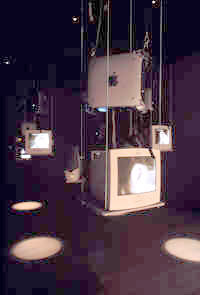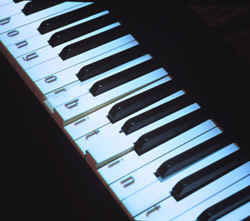Computer Voices / Speaking Machines (Sarah Cook reports from the Banff Centre, Canada)
On art, tech and the fallibility of the natural
New works by David Rokeby and Jocelyn Robert & Emile Morin Curated by Sara Diamond Walter Phillips Gallery, Banff Centre for the Arts May 19 - July 29, 2001 http://www.banffcentre.ca/WPG
 The exhibition which was on view this summer at Banff Centre was a coherent demonstration of new media art's increasing sensitivity towards the fallibility of the natural. The two pieces in my view do not, according to the press release "address the loss of voice, identity and free speech, at the turn of the millennium and in the wake of new technologies" (why, oh why, do press releases have to be so full of sound bites?) but rather show a marked consideration of the uniqueness of the human being. The exhibition attempts to both listen and respond to the presence of individuals.
The exhibition which was on view this summer at Banff Centre was a coherent demonstration of new media art's increasing sensitivity towards the fallibility of the natural. The two pieces in my view do not, according to the press release "address the loss of voice, identity and free speech, at the turn of the millennium and in the wake of new technologies" (why, oh why, do press releases have to be so full of sound bites?) but rather show a marked consideration of the uniqueness of the human being. The exhibition attempts to both listen and respond to the presence of individuals.
David Rokeby's beautifully installed piece n-Cha(n)t (the title a play on both "chant" and "chat") consists of seven G4 Macintosh hard drives suspended above monitors and below keyboards. On either side of each monitor are two speakers and above, a pencil thin microphone. The monitors are at eye level height, a spotlight marks the place on the floor where you stand. The image on the screens alternates between a close shot of an ear with an individual's hand either cupped around it or covering it or not there at all (I'm listening, I'm not listening, I'm indifferent). Superimposed on the image scroll words. If you speak into the microphone your voice is recognised and your words reproduced, and spoken back to you. The software is accurate and poetic in equal measure.
I say "begin again"; it says "the beginning." Occasionally the computer just takes one word from your phrase and improvises other phrases with alternate meanings of the word you've spoken. When the ear is covered it doesn't listen at all. A game of patience emerges - you wait until the machine is ready to hear you, and then you enunciate; it listens and replies. The longer you stand silently, the more the 7 computers (which are an even mix of women - speaking Victoria, and men - speaking Bruce) begin to listen to one another. When the room is empty of visitors, the computers chant phrases from the database in unison like a disembodied Dadaist choir.
 Jocelyn Robert and Emile Morin's La Salle des Noeuds III is more complicated at first glance for its curious complications are on the level of visible hardware not invisible software, though the work is less rewarding than Rokeby's physically and performatively. The installation has four parts. 1) A piano rigged up to a GPS device, playing a random composition. About this I know nought else. 2) Hanging from the ceiling in a square in the middle of the gallery are 20 strands of wire, on each are 6 electrical relays (this creates a curtained-like room in which are chairs you can sit on). 3) Hanging from the ceiling in a long, curved row are 20 more strands of wire, on each are 6 speakers. 4) Projected onto the wall in a gap between those strands of speakers is a video, moving almost unmanageably fast showing portraits of people saying "ahh". So, you've got 120 relays and 120 speakers individually emitting one-at-a-time 120 vocalisations and 120 images of different individuals. With the help of the mathematical system known as the Lorenz Attractor, these are all linked in a non-chaotic (but still very rapid) fashion. One relay to one speaker to one image to one sound; click, ahh, blink, click, ahh, blink is the general effect on the viewer. The idea is that the locations of the people (and hence sounds) can change (they were submitted via the web), but that the result is always "three different readings of one basic system". Like a number of recent new media audio compositions that seek to isolate individual sounds from the whole, La Salle des Neouds III becomes in essence an environment for detached contemplation. It's immersive but not interactive.
Jocelyn Robert and Emile Morin's La Salle des Noeuds III is more complicated at first glance for its curious complications are on the level of visible hardware not invisible software, though the work is less rewarding than Rokeby's physically and performatively. The installation has four parts. 1) A piano rigged up to a GPS device, playing a random composition. About this I know nought else. 2) Hanging from the ceiling in a square in the middle of the gallery are 20 strands of wire, on each are 6 electrical relays (this creates a curtained-like room in which are chairs you can sit on). 3) Hanging from the ceiling in a long, curved row are 20 more strands of wire, on each are 6 speakers. 4) Projected onto the wall in a gap between those strands of speakers is a video, moving almost unmanageably fast showing portraits of people saying "ahh". So, you've got 120 relays and 120 speakers individually emitting one-at-a-time 120 vocalisations and 120 images of different individuals. With the help of the mathematical system known as the Lorenz Attractor, these are all linked in a non-chaotic (but still very rapid) fashion. One relay to one speaker to one image to one sound; click, ahh, blink, click, ahh, blink is the general effect on the viewer. The idea is that the locations of the people (and hence sounds) can change (they were submitted via the web), but that the result is always "three different readings of one basic system". Like a number of recent new media audio compositions that seek to isolate individual sounds from the whole, La Salle des Neouds III becomes in essence an environment for detached contemplation. It's immersive but not interactive.
 The two works pair ideas of automation (each letting the machine do the work) against the fallibility and uniqueness of the human being -- the ones producing the sound, and hence the content. It's a solid reminder that telephony -- with its glitches, nuances, clicks, whispers and wires which connect only two people at a time in an intimate conversation -- was invented in Canada, the land of great distances. Moreover these works seem to be trying to say something about the one-to-one of the old telephone system and the many-to-many of the new digital but no less human network.
The two works pair ideas of automation (each letting the machine do the work) against the fallibility and uniqueness of the human being -- the ones producing the sound, and hence the content. It's a solid reminder that telephony -- with its glitches, nuances, clicks, whispers and wires which connect only two people at a time in an intimate conversation -- was invented in Canada, the land of great distances. Moreover these works seem to be trying to say something about the one-to-one of the old telephone system and the many-to-many of the new digital but no less human network.
Mute Books Orders
For Mute Books distribution contact Anagram Books
contact@anagrambooks.com
For online purchases visit anagrambooks.com






